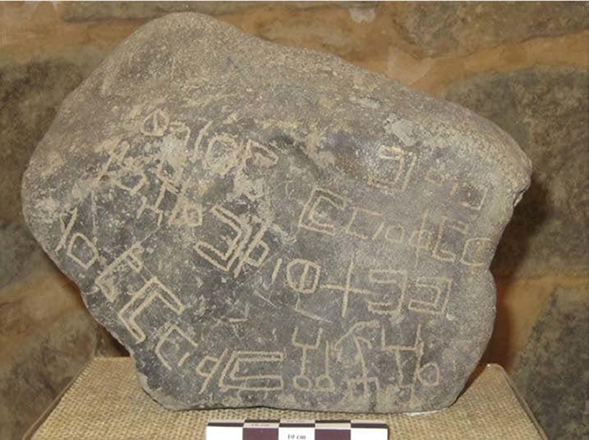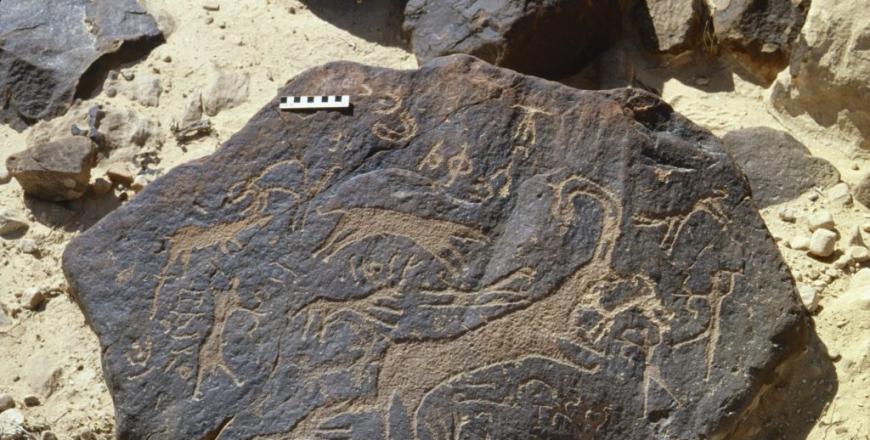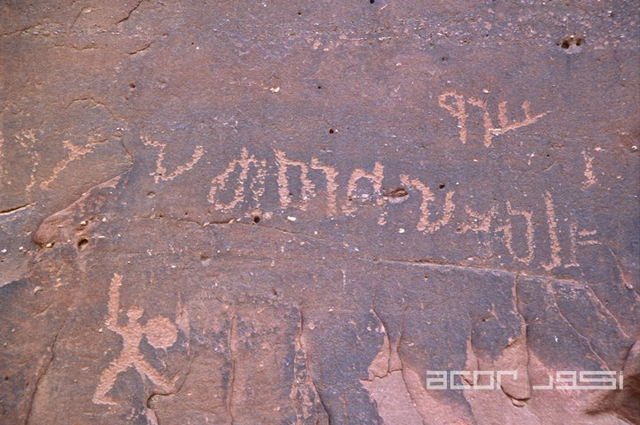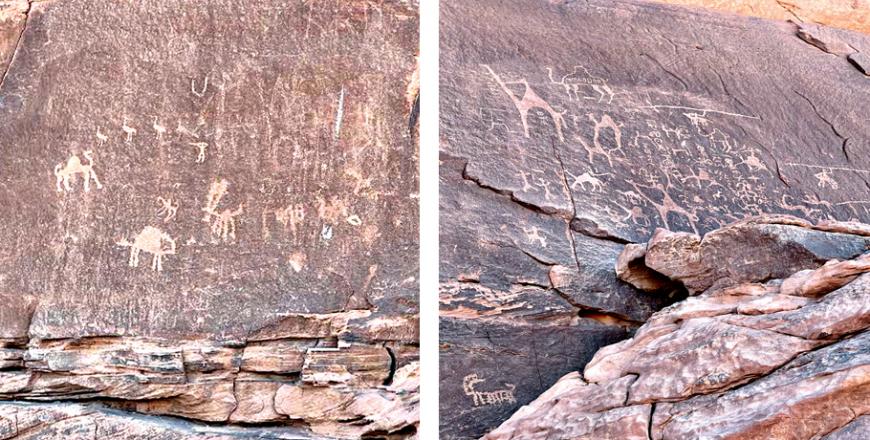You are here
New insights emerged into ancient Safaitic script
By Saeb Rawashdeh - Sep 19,2024 - Last updated at Sep 19,2024

The Safaitic inscription bearing the name Dmṣy (Photo courtesy of Irbid Museum)
AMMAN — The Safaitic script belongs to the group of South Semitic scripts and was used by Arabs in southern Syria, northern Jordan and the area of the Black Desert. There are thousands of inscriptions in Safaitic curved in rocks that Arabic and international experts spent decades deciphering.
The Safaitic script also belongs to the Ancient North Arabian (ANA) sub-grouping of the South Semitic scrip family, and the Safaitic writing system consists of 28 graphemes, each corresponding to a consonantal phoneme, while vowels are not represented. Safaitic inscriptions owned its name after the area where they were first discovered in 1857: As-Safa, a region of basalt desert to the southeast of Damascus.
According to the recent works of the professor Ahmad Jallad from Ohio State University, the Safaitic is an Old Arabic language.
Within the Safaitic script, there is a great extent of graphic variation, and one can single out different scripts, that is, different inventories of basic shapes, said Della Puppa from Leiden University in the Netherlands.
"The ANA group includes the scripts of three ancient Arabian oases – Dadanitic, Taymanitic and Dumaitic – and the scripts used in the deserts from the southern Levant to south-western Arabia: Safaitic, Hismaic, Thamudic B, C, D, 23 and Himaitic 24 (former Southern Thamudic). The ANA inventories that are closest to the Safaitic script are: Thamudic B, which is found in largest concentrations in the Najd and in the area between Madain Salih and Tayma in north-west Saudi Arabia and Hismaic, which is primarily found in the Ḥismā desert of southern Jordan and in the area around Tabuk in north-west Saudi Arabia," Puppa underlined.
While there is still no comprehensive study of the Thamudic B script, a detailed analysis of the graphetic features of the Hismaic script was carried out by the late Geraldine King in her doctoral thesis, the scholar said, adding that the ANA scripts are clearly related, but their developments and interrelationships are unclear, especially since we lack any precise chronology.
"While comparing these scripts it appears that, although there are a number of shapes which are identical – or at least very similar – across scripts [e.g. the shapes of d , y, and w ], there are also similar or identical shapes which have completely different graphematic values from one script to the other. In some cases, this may be the result of parallel development," Puppa noted, adding that a British scholar Macdonald points at the example of the straight vertical line shape, which is used for n in Thamudic B, for r in Thamudic D, for s² in Hismaic, and for l in Safaitic.
This shape may have developed independently in each script. However, there are two cases for which parallel development can probably be ruled out: 1) the shape, which is used for the ḍ in ‘common’ Safaitic and Thamudic B, while it represents the grapheme ṯ in Hismaic; 2) the shape, which expresses the ṯ in Safaitic and Thamudic B forms, while it is used for the g in Hismaic, Puppa explained, adding that such examples clearly show the inadequacy of uni-evolutionary models which see the various ANA inventories as the result of a single gradual development from one script to the other, since they suggest that the process by which some ANA scripts developed involved the adoption as well as deliberate rearrangement and modification of pre-existing inventories.
The style of Safaitic inscriptions is laconic and formulaic; virtually all texts start with l, the so-called lām auctoris, followed by the name of the author.
The subject of inscription is limited and belongs to a few common cathegories-
drawings, statements concerning the author’s activity (such as pasturing, camping,
migrating, keeping watch, raiding, etc.), mention of unfavourable conditions (e.g.,
drought, war, etc.), statements concerning the author’s emotions (mainly longing and grieving), prayers, curses and dating.
The first major collections of Safaitic inscriptions were from modern southern Syria.
"In 1943, Littmann published an edition of 1302 Safaitic texts collected within the
framework of the Princeton Archaeological Expedition to Syria in 1904-1905 and 1909. The year 1950 saw the publication of the Corpus Inscriptionum Semiticarum, Par, edited by G. Ryckmans, which contained 5380 Safaitic texts," Puppa said.
The following decades have witnessed the publication of an increasing number of
Safaitic collections, most of which are from north-eastern Jordan.
"The OCIANA, edited by Ali Manaser and Michael Macdonald, provide access to most published and unpublished collections of Safaitic texts, including various MA theses and PhD dissertations, and adds photographs of the texts whenever available, together with an up-to-date edition and translation. At present, it contains 33,339 records of Safaitic texts," Puppa underscored.
Related Articles
AMMAN – The late Australian scholar from The University of Sydney, William Jobling, meticulously studied inscriptions in the Wadi Rum back i
AMMAN — In order to have centralised information about inscriptions from Ancient North Arabia, a group of scholars created “The Online Corpu
AMMAN — The 12,000 years of human occupation in the Arabian Peninsula are illustrated through the diverse markings left by various civilisat

















